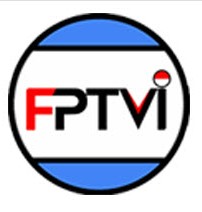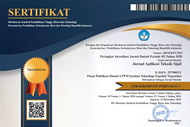Eksplorasi Analysis Structural Equation Modelling – (SEM PLS) untuk Faktor Berpengaruh dalam Penerapan Green Retrofitting Industri Beton di Indonesia
Abstract
Keywords
Full Text:
PDFReferences
R. Bayuaji, R. W. Kurniawan, A. K. Yasin, H. A. Takwim, and F. M. Afifah, “Material Inovatif Ramah Lingkungan: Pemanfaatan Komposit Abu Serabut Kelapa dan Fly Ash pada Pasta Semen,” J. Apl. Tek. Sipil, vol. 13, no. 1, p. 15, 2015, doi: 10.12962/j12345678.v13i1.1590.
A. I. Imron and A. E. Husin, “Peningkatan Kinerja Biaya Berbasis Value Engineering Pada Proyek Green Hospital,” J. Apl. Tek. Sipil, vol. 19, no. 3, p. 323, 2021, doi: 10.12962/j2579-891x.v19i3.9144.
G. Kashwani, A. Sajwani, M. Al Ashram, and R. Al Yaaqoubi, “Evaluation of Environmental Requirements for Sustainable Ready-Mix Concrete Production in Abu Dhabi Emirate,” no. March, pp. 333–339, 2014.
S. Hidayah and A. E. Husin, “Faktor-Faktor yang Paling Berpengaruh pada Pekerjaan Retrofitting Rumah Sakit Berbasis Peraturan yang Berlaku di Indonesia,” vol. 20, pp. 323–332, 2022.
J. Pahnael, A. Soekiman, and M. Wimala, “PENERAPAN KEBIJAKAN INSENTIF GREEN BUILDING DI KOTA BANDUNG (Green Building Incentive Policy in Bandung),” J.Infras, vol. 6, no. 1, pp. 1–13, 2020.
J. Kim, D. Ph, M. Asce, M. Greene, S. Kim, and D. Ph, “Cost Comparative Analysis of a New Green Building Code for Residential Project Development,” pp. 1–10, 2014, doi: 10.1061/(ASCE)CO.1943-7862.0000833.
T. M. Version, “Concrete Sustainability Council.”
A. E. Husin, “Implementation Value Engineering In Diaphragm Wall at High Rise Building,” vol. 8, no. 1, pp. 16–23, 2019.
A. E. Husin, “Model Aliansi Strategis Dalam Kemitraan Pemerintah dan Swasta Pada Mega Proyek Infrastruktur Berbasis Value Engineering Untuk Meningkatkan Nilai Kelayakan Proyek,” pp. 1–337, 2015.
T. C. Marrana, J. D. Silvestre, J. de Brito, and R. Gomes, “Lifecycle Cost Analysis of Flat Roofs of Buildings,” J. Constr. Eng. Manag., vol. 143, no. 6, p. 04017014, 2017, doi: 10.1061/(asce)co.1943-7862.0001290.
G. Jonathan and B. Anondho, “Perbandingan Antara Pls Sem Dan Analisis Faktor Untuk Identifikasi Faktor Pengaruh Eksternal Proyek,” JMTS J. Mitra Tek. Sipil, vol. 1, no. 2, p. 123, 2018, doi: 10.24912/jmts.v1i2.2668.
J. Sarwono and U. Narimawati, “Membuat Skripsi, Tesis, dan Disertasi dengan Partial Least Square SEM (PLS-SEM),” Academia, p. 226, 2015.
S. Jonathan, “Pengertian Dasar Structural Equation Modeling (SEM),” J. Ilm. Manaj. Bisnis Ukrida, vol. 10, no. 3, p. 98528, 2010.
L. K. Harahap, “Analisis SEM (Structural Equation Modelling) Dengan SMARTPLS (Partial Least Square),” Fak. Sains Dan Teknol. Uin Walisongo Semarang, no. 1, p. 1, 2018.
J. F. Hair Jr, G. T. M. Hult, C. M. Ringle, M. Sarstedt, N. P. Danks, and S. Ray, Partial least squares structural equation modeling (PLS-SEM) using R: A workbook. 2021.
K. H. Gupta and A. Gaikwad, “Analytical Hierarchy Process ( AHP ) for Feasibility of Ready Mix Concrete Plant ISSN : 1001-1749 Analytical Hierarchy Process ( AHP ) for Feasibility of Ready Mix Concrete Volume XVI , Issue VI , JUNE / 2020 Page No : 131,” no. June, 2020.
S. Su, Y. Gong, B. Tan, J. Pi, M. Weng, and Z. Cai, “Area Social Deprivation and Public Health : Analyzing the Spatial Non-stationary Associations Using,” Soc. Indic. Res., no. 129, 2016, doi: 10.1007/s11205-016-1390-6.
T.-L. Weng, W.-T. Lin, S.-H. Weng, and K.-T. Chang, “The Study of Choice the Ready Mix Concrete Materials Factory Plant,” DEStech Trans. Eng. Technol. Res., no. apetc, pp. 1116–1123, 2017, doi: 10.12783/dtetr/apetc2017/11165.
B. Li, A. Akintoye, P. J. Edwards, and C. Hardcastle, “Critical success factors for PPP/PFI projects in the UK construction industry,” Constr. Manag. Econ., vol. 23, no. 5, pp. 459–471, 2005, doi: 10.1080/01446190500041537.
M. Donner, A. Verniquet, J. Broeze, K. Kayser, and H. De Vries, “Critical success and risk factors for circular business models valorising agricultural waste and by-products,” Resour. Conserv. Recycl., vol. 165, p. 105236, 2021, doi: 10.1016/j.resconrec.2020.105236.
C. Scott-Young and D. Samson, “Project success and project team management: Evidence from capital projects in the process industries,” J. Oper. Manag., vol. 26, no. 6, pp. 749–766, 2008, doi: 10.1016/j.jom.2007.10.006.
T. Lager, “Success factors for improvement and innovation of,” no. May 2002, 2014, doi: 10.1108/0957606021041660.
M. Antikainen and K. Valkokari, “A Framework for Sustainable Circular Business Model Innovation,” Technol. Innov. Manag. Rev., vol. 6, no. 7, pp. 5–12, 2016, doi: 10.22215/timreview1000.
R. Pozzi, T. Rossi, and R. Secchi, “Industry 4.0 technologies: critical success factors for implementation and improvements in manufacturing companies,” Prod. Plan. Control, vol. 0, no. 0, pp. 1–21, 2021, doi: 10.1080/09537287.2021.1891481.
A. Bakri, A. Nur Aizat Ahmad, and M. Arif Mahzan, “a Review on Critical Success Factors for Total Productive Maintenance and Development of Research Framework,” vol. 7, no. 2018, pp. 548–552, 2017.
R. F. Aziz, “Statistical model for predicting and improving ready mixed concrete batch plants’ performance ratio under different influences,” Alexandria Eng. J., vol. 57, no. 3, pp. 1797–1809, 2018, doi: 10.1016/j.aej.2017.06.016.
J. Rivera, M. A. Naranjo, J. Robalino, F. Alpizar, and A. Blackman, “Local Community Characteristics and Cooperation for Shared Green Reputation,” Policy Stud. J., vol. 45, no. 4, pp. 613–632, 2017, doi: 10.1111/psj.12156.
D. Jo and C. Kwon, “Structure of green supply chain management for sustainability of small and medium enterprises,” Sustain., vol. 14, no. 1, 2022, doi: 10.3390/su14010050.
N. Mohamed, W. H. W. Mahmood, M. R. Muhamad, and M. Z. Yusup, “Initial study of factors on green supply chain management, green supplier strategy and work system performance,” Int. J. Integr. Eng., vol. 12, no. 5, pp. 178–184, 2020, doi: 10.30880/ijie.2020.12.05.021.
T. Ahmad, A. A. Aibinu, and A. Stephan, “Green Building Success Criteria: Interpretive Qualitative Approach,” J. Archit. Eng., vol. 27, no. 1, p. 04020045, 2021, doi: 10.1061/(asce)ae.1943-5568.0000448.
A. Nawaz, X. Su, Q. M. U. Din, M. I. Khalid, M. Bilal, and S. A. R. Shah, “Identification of the h&s (Health and safety factors) involved in infrastructure projects in developing countries-a sequential mixed method approach of OLMT-project,” Int. J. Environ. Res. Public Health, vol. 17, no. 2, 2020, doi: 10.3390/ijerph17020635.
Z. Wei, B. Han, X. Pan, M. Shahbaz, and M. W. Zafar, “Effects of diversified openness channels on the total-factor energy efficiency in China’s manufacturing sub-sectors: Evidence from trade and FDI spillovers,” Energy Econ., vol. 90, p. 104836, 2020, doi: 10.1016/j.eneco.2020.104836.
W. Hu, J. Tian, and L. Chen, “Assessment of sustainable water stewardship and synergistic environmental benefits in Chinese industrial parks,” Resour. Conserv. Recycl., vol. 170, no. April, p. 105589, 2021, doi: 10.1016/j.resconrec.2021.105589.
E. Giovanis and O. Ozdamar, “Health status, mental health and air quality: evidence from pensioners in Europe,” Environ. Sci. Pollut. Res., vol. 25, no. 14, pp. 14206–14225, 2018, doi: 10.1007/s11356-018-1534-0.
J. F. De Medeiros, J. L. D. Ribeiro, and M. N. Cortimiglia, “Success factors for environmentally sustainable product innovation: A systematic literature review,” J. Clean. Prod., vol. 65, pp. 76–86, 2014, doi: 10.1016/j.jclepro.2013.08.035.
A. Ng, R. D. Wirahadikusumah, and B. Hasiholan, “Kajian Good Practice Penerapan Value Engineering pada Industri Konstruksi Indonesia,” no. 1, pp. 20–21, 2021.
A. F. Kineber, I. Othman, A. E. Oke, N. Chileshe, and T. Zayed, “Exploring the value management critical success factors for sustainable residential building – A structural equation modelling approach,” J. Clean. Prod., vol. 293, p. 126115, 2021, doi: 10.1016/j.jclepro.2021.126115.
E. Plebankiewicz, “Model of predicting cost overrun in construction projects,” Sustain., vol. 10, no. 12, 2018, doi: 10.3390/su10124387.
T. Chow and D. B. Cao, “A survey study of critical success factors in agile software projects,” J. Syst. Softw., vol. 81, no. 6, pp. 961–971, 2008, doi: 10.1016/j.jss.2007.08.020.
M. Stanitsas, K. Kirytopoulos, and V. Leopoulos, “Integrating sustainability indicators into project management: The case of construction industry,” J. Clean. Prod., vol. 279, p. 123774, 2021, doi: 10.1016/j.jclepro.2020.123774.
M. A. Kristianto and V. Y. R. Damanik, “Analisis Life Cycle Cost Penerapan Vertical Greening Systems Di Indonesia,” Ultim. J. Komun. Vis., vol. 9, no. 2, pp. 74–80, 2018, doi: 10.31937/ultimart.v9i2.754.
M. Altaf et al., “Evaluating the awareness and implementation level of LCCA in the construction industry of Malaysia,” Ain Shams Eng. J., vol. 13, no. 5, p. 101686, 2022, doi: 10.1016/j.asej.2021.101686.
S. Haryono, “Mengenal Metode Structural Equation Modeling (SEM) untuk penelitian manajemen menggunakan AMOS,” J. Ekon. dan Bisnis STIE YPN Vol. VII No. 1 Oktober 2014, vol. VII, no. 1, pp. 23–34, 2014.
J. F. Hair, M. Sarstedt, L. Hopkins, and V. G. Kuppelwieser, “Partial least squares structural equation modeling (PLS-SEM): An emerging tool in business research,” Eur. Bus. Rev., vol. 26, no. 2, pp. 106–121, 2014, doi: 10.1108/EBR-10-2013-0128.
Ghozali & Laten 2015, “Partial Least Squares Konsep,Teknik Dan Aplikasi Mengunakan Program SmartPLS 3.0 (2nd ed.),” Acad. (Accelerating world’s Res., pp. 1–8, 2018.
DOI: http://dx.doi.org/10.12962%2Fj2579-891X.v21i1.14590
Refbacks
- There are currently no refbacks.

Jurnal Aplikasi Teknik Sipil by Pusat Publikasi Ilmiah LPPM Institut Teknologi Sepuluh Nopember is licensed under a Creative Commons Attribution-ShareAlike 4.0 International License
Based on work at https://iptek.its.ac.id/index.php/jats




